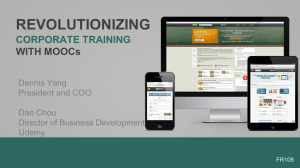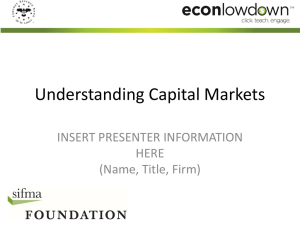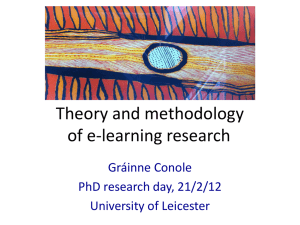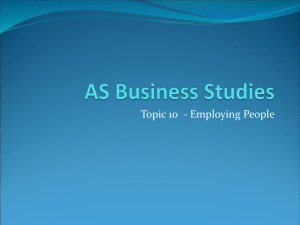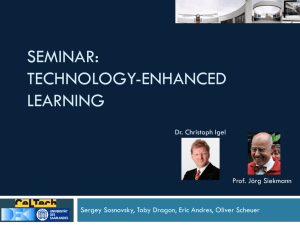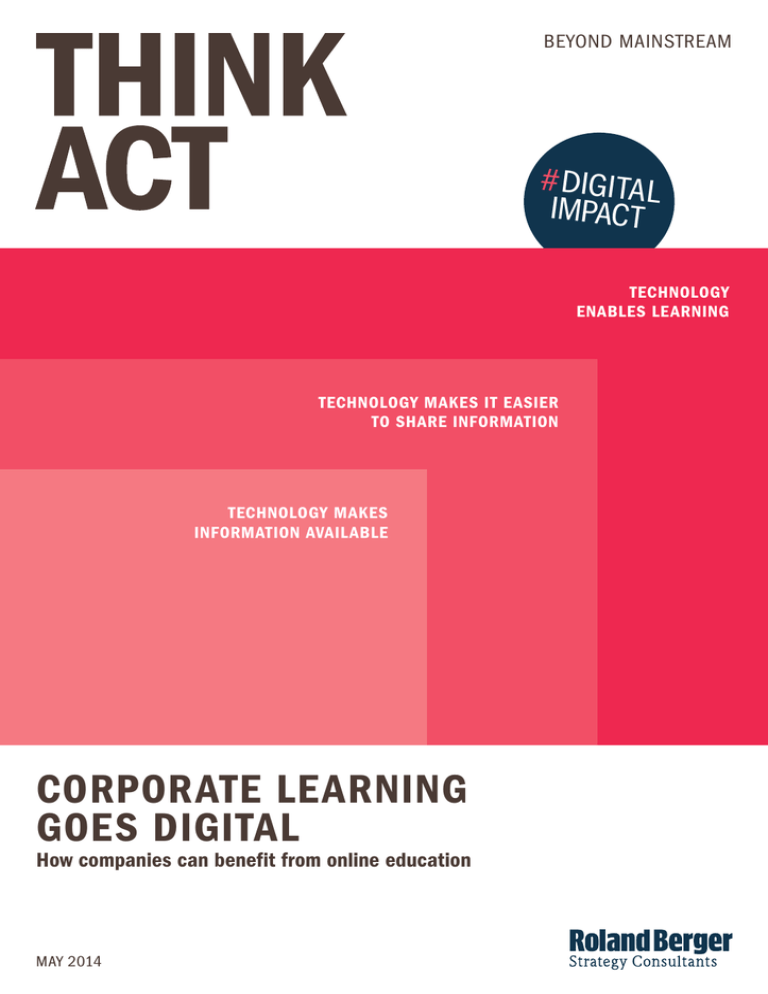
BEYOND MAINSTREAM
# DIGI TAL
IMPACT
TECHNOLOGY
ENABLES LEARNING
TECHNOLOGY MAKES IT EASIER
TO SHARE INFORMATION
TECHNOLOGY MAKES
INFORMATION AVAILABLE
CORPORATE LEARNING
GOES DIGITAL
How companies can benefit from online education
MAY 2014
THINK ACT
CORPORATE LEARNING
THE BIG 3
1
3,000
companies in Europe are involved in the e-learning business.
The market is booming. Facts and figures on corporate learning
p. 4
2
13%
growth per year and set to double by 2018: these are the forecasts for
the corporate e-learning market – valued in the billions, it's one of the
most impressive success stories in the education sector, itself already
enjoying strong growth
p. 5
3
6+1
To dos: six optimistic principles and one precaution
p. 11
New
technology,
more
creativity
p. 14
2
ROLAND BERGER STRATEGY CONSULTANTS
THINK ACT
CORPORATE LEARNING
The challenge for corporate learning:
Corporate management wants to see
measurable contributions to success.
What measurable successes – in business-speak: returns on investment – can be achieved by investing in
continuing education for employees? What contribution does corporate learning make to companies' value
creation, cultural transformation, strategy implementation or improving operating business? The pressure
on those in charge of corporate learning to justify their
existence has increased.
At the same time, company managers and corporate learning experts are being confronted with serious
challenges that they have to answer:
TIME PRESSURE. "Strategy development" used
to mean extensive analysis followed by planning. But
today, with increased dynamics and complexity in their
industries, companies often don't have the time to unhurriedly systematically formulate strategies. Instead,
they develop short-term strategies or start implementation in parallel, since a company's agility is a key
competitive factor. This shortens the time in which the
change processes can be supported with training
offerings. More than ever, it's important for companies
to quickly define and implement the right actions.
Learning is thus no longer an option – it's a strategic
imperative!
GLOBALIZATION PRESSURE. The more international a company's locations, workforce and markets,
the more important it is for its corporate learning options to be available worldwide. Standards need to be
ensured and redundancies in design, development and
provision avoided.
COST PRESSURE. Companies that have successfully emerged from the global financial crisis of
2008 have once again made themselves more efficient and stepped up the scrutiny of internal service
providers and general administration costs. Global
competition is forcing companies to constantly review
all cost items. This development affects corporate
learning in two ways:
One, many companies have cut out every bit of
"organizational slack". Optimized processes and more
tightly packed work have limited the time employees
have for exploring areas beyond their current tasks and
expanding their competence portfolio with internal
learning opportunities.
Two, in addition to the cost of designing, developing and maintaining the offering, the costs of corporate
learning are being viewed especially critically, particularly costs for trainers, travel and infrastructure.
These two aspects result in increased demand for
offerings that make it possible to learn at the office
and which can be better integrated into operating processes – as opposed to rigid, time-consuming seminars. Learning modules ("bite-sized learning nuggets")
that are flexible in terms of time and location are the
new form of sharing knowledge: this is one requirement
facing the corporate learning field.
What's more, growing cost pressure as well as strategic considerations are pushing corporate learning
divisions to provide offerings for customers, suppliers
or potential recruits.
In addition, stricter risk management and legal regulations that place demands on corporate governance
mean that documented review of individual learning
progress in many areas is becoming more important.
ROLAND BERGER STRATEGY CONSULTANTS
3
THINK ACT
CORPORATE LEARNING
1
CORPORATE LEARNING
FACTS AND FIGURES
77%
In 1995, only 4% of US companies offered e-learning
in their professional development programs – today it is 77%
91,000,000,000
The entire e-learning market (i.e. not just corporate learning) today is already worth USD 91 billion –
It is forecast to grow by over 20% annually up through 2017
13%
The market for corporate e-learning is expected to grow
13% per year up through 2017
3,000
Companies in Europe are involved in the e-learning business. The competition
and significant investment will likely give rise to major innovations in e-learning
100
Of India's 140 e-learning companies were founded in the past three years
4
ROLAND BERGER STRATEGY CONSULTANTS
THINK ACT
CORPORATE LEARNING
It's not just the requirements at the macro level that
have changed – the expectations of the customer, or
"learner", need to be considered (micro perspective).
Three aspects are to be taken into account.
DIVERSIT Y. Having locations stationed around
the globe means employees are also stationed around
the globe: people with radically different backgrounds
and levels of education are supposed to work closely
together and meet certain training standards independent of their own individual starting points. Cultural
differences also yield a range of preferences for learning formats and therefore differing levels of willingness
to learn.
DIGITAL NATIVES. The demand for continuing
education changed with Generation Y. Those born after
1980, also referred to as digital natives, have entered
the workforce – and they are open for technology
trends. They intensively use applications in all situations. They therefore see no reason why education/
learning shouldn't happen online. They are used to
having knowledge available anywhere, anytime and
tend to look for it at the last minute. They are active in
online social networks, but at the same time prefer to
learn "face-to-face". A recent study by Allen/Seaman
shows that 6.7 million American college students, or
about one third, already use online education options
– and this figure is on the rise. They take this habit with
them into the professional world.
LIFELONG LEARNING and longer (working) lives.
The labor force in many countries is getting older, retirement age is rising. With knowledge increasing exponentially and requirements in the workplace constantly
changing, employees have to always improve their
skills to maintain their "employability". With only a small
fraction of employees able to afford the time and money
to periodically go back to school full-time, professional
development is taking on a bigger and bigger role.
Could online learning offer a solution to the challenges described above? We believe there are many
reasons to expect that online education will surge in
importance over the next few years. The transformation will be driven by a technology push, a demand pull
and a demographic kick. Experts estimate that in
2011, companies around the world spent USD 210 billion on corporate learning, about 20% of which went to
corporate e-learning. Observers such as Global Industry Analysts in California or investment banking service
provider IBS Capital in London predict that the market
for corporate e-learning will grow at an average rate of
13% per year. This means that the market will have 2
doubled again by 2018 at the latest.
Corporate e-learning is thereby proving to be one of
the most impressive growth segments in the education
industry, which is itself enjoying strong growth. Already
by 2011, 51% of Europe's companies offered an online
training unit, which more than half of their employees
had made use of. Among European countries, England
and Spain have the greatest preference for e-learning
– if somewhat less than in the US. By that same year,
77% of the companies there used e-learning.
In short: Online education has the potential to
revolutionize how we learn, whether on the college
campus or in the office. Online technologies paired
with social media are changing supply and demand
from the ground up. This disruptive change results in
new business models for training providers – and with
them, new opportunities for the future of lifelong learning at companies. Digitalization will also lead to massive changes in corporate learning, similar to what
Amazon did to bricks and mortar retail.
ROLAND BERGER STRATEGY CONSULTANTS
5
THINK ACT
CORPORATE LEARNING
The answer. New diversity on the
online education market.
Once again, the internet is changing the rules of the
game. It's giving the education market a completely
new image. Rising venture capital investment is a measure of the positive expectations that the market has of
online education: in 2005, investment in technological
advancement amounted to USD 52 million. In 2012,
this had multiplied by over 20 times: USD 1.1 billion in
venture capital was invested in online education –
approx. 60% of which in the US. This new education
market reached a significant size some time ago and
further growth is expected. Therefore, there is a commercial answer to the changes on the market, with crucial technological product innovations. Social interactions between the trainer and the trainee, creative
learning such as collaboration and group work among
students are commonplace in today's online learning.
This means that the second generation of online training offerings is considerably further advanced than the
first generation, which debuted on the market about
ten years ago.
At the same time, technological advancements
have made online educational offerings more accessible. Transmission bandwidth and speed as well as
data processing and storage capacity have increased.
The number of people who access the internet using a
smartphone, tablet or PC has grown exponentially.
Whereas 64% of the European Union's population was
online in 2008, in 2013 it was already up to nearly
78% – more than 390 million people. In emerging
economies, growth is even more rapid. Between 2013
and 2019, the number of smartphone users is expected to triple to over 5.5 billion people, and the amount
of data shared via smartphone is forecast to increase
by a factor of 10. The costs of these technologies have
6
declined. Taken together, these developments mean
the potential for mobile learning ("m-learning") has risen considerably.
Policymakers in various countries have also recognized the business potential of online education and
are promoting promising initiatives. South Korea was
one of the first to take action here. As of 2013, the EU
has supported an initiative entitled "Open Education
Europa", which aims to bundle and promote the online
education offerings of various providers. Several notable initiatives have also cropped up recently in individual European countries, such as "France Université
Numérique" (FUN), which has been given "national
priority" in France.
The French have "FUN"
The objective of "FUN" is to provide higher education
online for all. The initiative is expressly devoted to continuing professional development in companies. In
Germany, a country characterized by "educational federalism", the federal states support projects such as
"Virtuelle Hochschule Bayern" (Virtual University of Bavaria). At the national level, the Federal Ministry of Education and Research supports a program for digital
media in education. The Federal Ministry for Economic
Affairs is developing a strategy for "intelligent networks"; one of the areas it will deal with is education.
One more thing speaks for online offerings: with the
pan-European bachelor/master degree system and the
European Credit Transfer and Accumulation System's
(ECTS) standards, the EU has created a uniform system for recognizing educational degrees. Using these
standards, companies can better understand which
ROLAND BERGER STRATEGY CONSULTANTS
THINK ACT
CORPORATE LEARNING
level of academic education is provided by a particular
education offering – regardless of country or provider.
The various education offerings, whether online or traditional, are easier to compare.
The number of technological solutions for online
education is growing as is the number of content providers. Besides established professional development
providers, more and more publishing houses and media outlets are getting involved. As advertising revenues fall, the demand for professional development is
rising and offers new business models. If they haven't
done so already, quite a few publishing houses and
media outlets are diversifying into education groups,
of course with an increasing amount of online offerings
in the portfolio. B
In addition to the countless education firms experiencing strong growth, innovative start-ups are showing
up everywhere that have aligned their business models
to the lucrative growth market for e-learning and other
online educational opportunities. Currently, IBIS Capital estimates that the European e-learning market
alone consists of about 3,000 predominantly smaller
companies. They have a range of business models that
cover the entire value chain: from content development
and the technological platform, i.e. the management
system for teaching and learning, to organizing and arranging training courses. This in turn covers the whole
spectrum of e-learning, from blended and social learning to mentored and mobile learning. This fragmentation can be interpreted as a sign of the relative immaturity of the market, while also reflecting the wide
variety of market conditions in individual European
countries. In the future, many of these providers will
probably consolidate.
Harvard is just a click away
is of strategic relevance for top universities as well. The
prices for higher education have risen steadily, particularly in the US – often more than the students can
comfortably afford. Online education has therefore become even more attractive as a more affordable version of high-quality university courses. Initially, the
idealistic notion of free education took the spotlight:
for everyone, anywhere, at any time. Technology has
made this vision a tangible reality. Internationally
renowned courses are just a click away on a tablet:
Harvard at your fingertips.
MOOCs, massive open online courses for hundreds
of thousands of students, were the magic word. Others
saw these interactive video courses simply as a marketing channel for the regular, fee-based program consisting of traditional classroom teching and e-learning
courses. A
The well-known universities with their strong brands
have already developed successful offerings in the
field of executive education. More of these are now
online, such as the "Harvard Managementor". If these
universities and their publishing houses are now setting up and expanding their online courses, further
strong impetus is likely.
What's incredible for those at companies purchasing learning offerings is that many established distance-learning universities in Europe are not much
more innovative in online teaching than traditional universities – despite their proven experience in distance
teaching and the potential threat presented by other
players entering the market.
But in any case a clear signal has been sent. Premium education is now available online too. This will soon
be visible on applicants' CVs. There should no longer
be any reservations about the medium. Instead, companies should systematically use online learning.
Even the world of higher education is in flux – with important implications for companies. Up until 2011, it
was mostly less well-known colleges and universities
that attempted to raise their profile with online offerings. However, now Harvard, Stanford and MIT have
joined the fray, underscoring the fact that the internet
ROLAND BERGER STRATEGY CONSULTANTS
7
THINK ACT
CORPORATE LEARNING
A
MOOCs, POOCs, SPOCs
ABBREVIATIONS FOR THOSE IN THE KNOW
MOOC stands for massive open online course. These
include (video) courses that may have large numbers
of participants, can be taken without any entrance requirements, mostly free of charge (open) and offered
online. The courses can be viewed any number of times
whenever and wherever students want. Students have
to answer test questions, in some cases with the support of online tutors. One key feature of this format is
that students interact online, work jointly on topics and
answer each other's questions. Brainstorming in a peer
group makes it unnecessary to have a trainer in some
cases.
MOOCs thus stand for a vision of a world with more
equal opportunities. They stand for free access to edu-
cation – an ideal that could improve many people's
lives if it becomes a reality. The New York Times dubbed
2012 the "Year of the MOOCs", because MOOCs were
being praised enthustiastically by everyone. A few dissenting voices pointed out that the students came
from industrialized countries and already had a certain
level of education. Added to this were the high dropout rates (90% or more) and a vague – in other words,
nonexistent – business model. As MOOCs are virtually
free for students, there is little money to be made, not
even from the fees for taking particular exams.
Despite this, MOOCs have maintained their role as
catalysts of the rapid transformation toward more online education. Stanford professor Sebastian Thrun,
PIONEERS OF THE TRANSFORMATION
The key MOOC platforms
NAME
FOUNDED IN ...
PARTNER UNIVERSITIES
MOOCs
USER
Coursera
2012 by Stanford Professors Andrew
Ng and Daphne Koller
108 universities from various
countries worldwide
627
6,400,000
OpenupEd
2013 by EADTU (Europe's Institutional
Network for Open and Flexible Higher
Education)
11 universities from various
countries, mainly in Europe
272
n.a.
edX
2012 by the Massachusetts Institute
of Technology (MIT) and Harvard
University
31 universities from various
countries worldwide
133
1,800,000
Future Learn
2013 by the Open University
26 universities mainly from the UK
plus several from Ireland, Australia
and New Zealand
44
200,000
UDACITY
2012 by former Stanford professor
Sebastian Thrun plus David Stavens
and Mike Sokolsky
3 universities
33
1,800,000
iversity
2011 by two German former students,
Jonas Liepmann and Hannes Klöpper
23 universities from various
countries, mainly in Europe
28
500,000
8
ROLAND BERGER STRATEGY CONSULTANTS
THINK ACT
CORPORATE LEARNING
SPOCs
= "small, private online courses"
SOOCs
= "selective open online courses".
Participants selected, e.g. based on
pre-qualification or on employer
TORQUEs POOCs
= "tiny, open online courses but with
definite restrictions, focusing on quality
and effectiveness"
the "godfather of MOOCs" as well as a Google genius,
recently announced a remarkable change at Udacity,
an online portal offering Stanford-level classes. The
portal will be providing fewer purely academic offerings
and more courses tailored to the specific needs of
companies. Thrun is not alone in this. It looks as if
some acronyms have already taken the lead: "SPOCs",
"SOOCs" and "POOCs" are just some of these.
There is already another MOOC provider, "First Finance", which has announced 20 MOOCs for the finan-
= "personalized open online
courses"
cial services industry by the end of 2014. Over 27,000
participants have apparently already signed up, and
120,000 is the goal.
Thrun and others will want to prove that MOOCs are
more than just a good story. The new goal is already
clear. Udemy, a Web platform for online learning, predicts that 2014 will be the "Year of Corporate MOOCs".
And why not?
ROLAND BERGER STRATEGY CONSULTANTS
9
THINK ACT
CORPORATE LEARNING
B
MEDIA TRANSFORMATION
INTERNATIONAL PUBLISHING AND MEDIA COMPANIES ARE FINDING
NEW BUSINESS OPPORTUNITIES IN ONLINE EDUCATION
PEARSON
HOLTZBRINCK PUBLISHING GROUP
UK
Germany
Publishers, sales of EUR 6.2 billion in 2013,
Focus on learning and online education (just under
80% of sales; approx. 45% online)
Family-owned publishers, incl. print and electronic
media, sales of EUR 1.9 billion in 2012, digital
realignment in 2000, investment focused on new
online business models, education and science/
academia
ONLINE EDUCATION: Pearson is one of the leading
providers of educational software and online
education – Claim: "The world's leading learning
company"
ACQUISITIONS: Over EUR 3 billion (GBP 2.5 billion)
since 2006, mainly in e-learning, incl. Exam Design,
TutorVista (India), Scoot & Doodle (USA), IndiaCanEducation (India), Learning Catalytics (USA)
ACQUISITIONS: MNV has over USD 100 million
in investment funds to be used to expand portfolio
by 2015
GRUPO PLANETA
REED ELSEVIER
Spain
UK/Netherlands
Publishers, bookstores, reading clubs and film
production, sales of EUR 2.8 billion in 2012
Publisher traditionally specializing in in academic
and specialist magazines, sales of EUR 7.1 billion
in 2013
ONLINE EDUCATION: Online offerings are aligned
to the Spanish labor market and are being continuously expanded
ACQUISITIONS in e-learning over the last few
years: VIU (online university), Aula Planeta, CEAC,
English Today ...
10
ONLINE EDUCATION: Involved mainly via subsidiary Macmillan Publishers (38% of group sales),
which includes Macmillan New Ventures MNV,
Macmillan Digital Education and Macmillan
Education
ONLINE EDUCATION: Sales involving electronic
media tripled over past ten years
ACQUISITIONS in e-learning over the last
few years: Mendeley (UK), Babbel (D),
fingerprint (USA) ...
ROLAND BERGER STRATEGY CONSULTANTS
THINK ACT
CORPORATE LEARNING
Corporate Learning.
What we need to do now.
Online corporation education is changing the rules of
play in each of the four stages of the value chain of
corporate learning. C
1. Defining what needs to be learned
Capacity and competencies: compare target versus
actual to define the boundaries of the learning offering. When analyzing learning requirements in the company, it is essential to understand what competencies
are required to achieve strategic goals. First you need
to be clear about employees' existing competencies.
Their formal qualifications are only the starting point,
because a person's first degree or first vocational
qualification becomes less important over the course
of his or her career. Further training thus becomes
more important. External online courses are both a
challenge and an opportunity for employers. Do they
suit the company's needs? It will become easier to
answer this question.
For successful participation in online courses, education providers such as the UK's Open University are
increasingly awarding "badges" – informal signs of accreditation. Professional online networks like LinkedIn
now display these badges on individual profiles, making it easier for potential employers to identify them.
What's more, MOOC pioneers such as Coursera and
edX are planning to – for a fee – transfer credits from
taking their classes to regular courses of study that
culminate in an accredited qualification. European universities have the option of awarding ECTS for certain
online courses. Badges and ECTS thus offer a way to
compare qualifications earned online.
Companies and industry associations could speed up
accreditation by stating training requirements more
proactively than before and developing their own badges or certificates as standards. This is already the
norm for accountants, because they have to do certain
further training in order to keep their licenses. Companies that can state requirements and set credible standards will influence the supply side and reap the benefits. Certificates issued jointly by training providers and
companies could be of interest to all parties:
> Employees would gain an accredited qualification in demand by employers and could do this at their
own pace while continuing to work.
> Companies could refine their competency portfolio with specific skills in a targeted way, regardless of
location. At the same time, employers would make
themselves more appealing by offering certified training for their employees.
> Conversely, learning providers could offer tailored, in-demand courses that people would be willing
to pay for.
2. Designing courses
Who should learn what, and how? Creating a learning
concept involves reviewing or refining educational offerings. Online education is the answer to current requirements for corporate learning, but the technology
should never be the focus: The content and teaching
concept is what's important. The use of online modules is always the result of a careful, comprehensible
selection. Online offerings are constantly becoming
more attractive and diverse. Here are a few examples:
ROLAND BERGER STRATEGY CONSULTANTS
11
THINK ACT
CORPORATE LEARNING
MODULARIZATION. Just as information and communication technologies are breaking up value chains in
industrial production (unbundling), the development of
online education leads to educational offerings previously offered only as a package, such as an MBA, being split into mini-packages, i.e. courses that let students accrue credits. This modularization enables
corporate learning units to cherry-pick what they want.
They are no longer tied to one provider for whole programs, but can collaborate on a course-by-course basis with individual providers due to falling transaction
costs. They can get in touch directly with the provider
or use new platforms such as Noodle, which pool offers and have search functions that enable transparency and targeted selection. As online education is not
linked to a specific location, the range of possible
partners is much bigger.
BLENDED LEARNING. In the infancy of e-learning, around the turn of the century, the technology de-
termined the teaching methods. E-learning meant
making educational materials available online. Today,
more value is placed on teaching methods and social
interaction has become a key factor in successful
learning. Education researchers agree that this is crucial in disseminating knowledge as well as in creativity,
and thus in creating new knowledge and solving problems: "You do not achieve knowledge creation through
containerization, you achieve it through collaboration."
That's how Don Tapscott, expert in technology and social innovation, summed up the findings. Thinking in
terms of departments, business units or corporate
boundaries must therefore be overcome. A mix of
methods usually leads to better educational results
than a single learning method. The result is called
blended learning – a mix of online studying and classroom teaching. Nowadays the concept is so advanced
that social interaction is possible even without a physical presence. D
C
VALUE CHAIN IN CORPORATE LEARNING
Capacity, competencies, control
1.
2.
3.
4.
DETERMINE
LEARNING NEEDS
(ANALYSIS)
DESIGN AND DEVELOP
COURSES
IMPART KNOWLEDGE
AND SKILLS
(DELIVERY)
CHECK KNOWLEDGE
APPLICATION/BEHAVIOR
CHANGE (EVALUATION)
> Derive requirements from
corporate goals
> Analyze existing capacity/
competency profiles
> Who should learn what,
and how? (develop
teaching strategy and
didactics)
> Check available offers to
set if they fit or design own
material
> Tell everyone about the
program and manage
participation and formats
> Generate the necessary
knowledge and/or convey
skills
> Evaluate (KPIs: participant
satisfaction, learning
progress, business impact)
> Determine learning needs
by comparing target versus
actual
> Define KPIs
> Develop a program
> Make a change in the way
employees think and work
> Determine ROI
> Identify any necessary
changes
INCORPORATING EVALUATION FINDINGS
12
ROLAND BERGER STRATEGY CONSULTANTS
THINK ACT
CORPORATE LEARNING
Online technologies should therefore remain at the heart
of corporate learning. They enable informal learning that
is spontaneous and on students' own initiative. Corporate learning must therefore provide infrastructure and
information as well as the right framework and incentives to get the right people to collaborate.
FLIPPED CLASSROOM. While the pure accumulation of knowledge can be done individually online,
the valuable time with students or in a study group
should be used to apply concepts, discuss them, clarify issues and review the subject matter learned
against the backdrop of social interaction. The lecture
or tutorial form is outdated – except for truly charismatic professors.
DIRECT PERFORMANCE SUPPORT. When
training people to use software, it is not usually possible or educationally sensible to teach the whole range
of functionalities of a software package – but the appropriate function must be able to be found when required. So this is a kind of just-in-time knowledge provision. Digital natives are familiar with this approach: if
they want to know more, they use their smartphone to
read a QR code. If a company holds back information,
it must make certain that if worst comes to worst, all
necessary information is available and is up to date,
easy to understand and immediately applicable.
AUGMENTED REALIT Y APPLICATIONS simulate information in three dimensions, thus making it
visible in a realistic way. They also enable a learning
situation in which projections are used and changed
interactively. This may help support students' powers
of imagination and make it easier to transfer what's
been learned to a specific work situation.
GAMIFICATION. A game-live environment transforms tasks into exciting challenges, rewards learners
for their commitment and is efficient in the form of
concrete feedback regarding their own skills. This improves acceptance and helps motivate the participants to get actively involved. In this case as well, the
learning speed of individual participants can be customized and the learning success precisely defined.
Well-thought-out games encourage commitment, critical thinking, creative problem solving and team work.
Whether the company buys the content for the various
teaching formats to be used in the company or develops it itself depends on a number of factors: How company-specific is the content and how good a fit are
external offers; how many participants are designated
by the company (scale effects); which options are
available for obtaining recognized certification or creditable performance points?
3. Disseminating knowledge and
enabling
Corporate learning focuses on changing mindset and
behavior at the workplace. Learning is complete only after a transfer to the work environment has been made.
We believe there are six optimal approaches and one 3
warning that need to be observed in online environment:
FIRST: The more geographically spread out the
participants, the more suitable online education is for
organizing communication and knowledge development among the participants.
Example: As one of the first international renowned
business schools without having a distance-learning tradition, Kenan-Flagler Business School is offering a complete MBA program online. This means participation is
possible, for instance, to even US naval personnel working on a submarine in the Pacific.
SECOND: The more heterogeneous the knowledge
level of the individual participants in terms of the curriculum is, the easier it is to realize the idea of a
"flipped classroom": Facts are imparted online and the
course can be prepared by way of virtual questions
and discussion forums so that during actual classroom
teaching there is time to focus on the already learned
concepts and discuss and practice these with the
trainer in detail.
Example: A strategy consultancy hires university
graduates with various different academic backgrounds.
The firm wants to ensure that through its HR development program that all consultants understand basic
business concepts and approaches. To initially impart
fundamental knowledge in topics such as strategy, organization and finance, the consulting firm draws upon the
ROLAND BERGER STRATEGY CONSULTANTS
13
THINK ACT
CORPORATE LEARNING
D
NEW TECHNOLOGY, MORE CREATIVIT Y
Social online technologies enable the development of interactive complex knowledge
High
"Develop
knowledge"
Social enterprise solutions/
social business solutions
(Wikis, blogs, live editing,
communities, microblogs,
forums, etc.)
3. T ECHNOLOGY ENABLES LEARNING AND
KNOWLEDGE CREATION (THAT OTHERWISE
WOULD NOT HAVE OCCURRED)
Online
voting function parallel
to meetings
2. TECHNOLOGY SUPPORTS THE
INFORMATION SHARING
(Detailed)
employee profiles
INNOVATION LEVEL
OF THE IMPARTED
KNOWLEDGE
1. TECHNOLOGY MAKES
INFORMATION
ACCESSIBLE
Web
conferences
RSS feeds
Podcasts
Intranet portals
Document management
systems
"Make knowledge
available"
(Knowledge)
databases
Low
Low
DEGREE OF SOCIAL INTERACTION AMONG LEARNERS AND TEACHERS
online education services offered by a renowned business school. The students can take a precise and flexible (in terms of timeframe and location) approach to
close any knowledge gaps. This also means they can
use the time between graduation and beginning their
new job to already start the learning process. (Participants can even collect credit points that can be used
later on in their career and credited to a Master or MBA
program.) Then in classroom training, the consultancy
can begin with a uniform level of knowledge among the
participants and start off immediately by teaching key
practical consulting concepts and company-specific approaches.
14
High
THIRD: Students studying in parallel to work have less
flexibility in terms of space and time to step away from
their daily work, which makes the options afforded by
online education all the more attractive.
Example: Sales staff at a major global pharmaceutical company need to always be on top of changes in
products, legislation and market or company developments. This means these employees receive specific
information and online training on their computers that
they can call up at any time. In turn, the company can
be assured that all its sales staff are always available
online and possibly check up on completed training
sessions.
ROLAND BERGER STRATEGY CONSULTANTS
THINK ACT
CORPORATE LEARNING
FOURTH: The more important it is to monitor individual learning targets and the more it has to be ensured
that a target group is up to speed on a specific topic
(e.g. making sure new staff is up-to-date on the latest
tools and techniques), the more suitable are e-learning
formats with "roll calls", exam questions and verification of the learning success.
Example: A company in the healthcare sector
needs to ensure that all employees are familiar with
the company's compliance rules from day one. The
company develops online training courses for the various employee groups. These courses use concrete
examples to illustrate proper behavior and all employees are obligated to take these courses. New hires
must have completed this within a certain amount
of time. Employees use multiple-choice tests to personally monitor their progress and must continue
until they have passed the test. The company can
monitor and document the progress of each individual
employee.
FIFTH: The more general the content that needs to
be learned, the more suitable are online offers compared to classroom teaching. This is because the new
topic can be learned wherever at the student's own
pace. This is known as the "Personal Learning Environment" (PLE). The technologies, systems and content
available to each employee at his or her workstation
make it possible to customize courses to the individual
needs and habits of each student. Learning can, for
instance, occur by collecting data and acquiring knowledge by sharing information with exactly those people
also interested in the same topic and experts within or
outside the company. And this can be leveraged even
further by collaborating or jointly developing know-how
and relevant applications.
Example 1: A global company with 100,000 employees has recently undergone a merger and integration. It wants to familiarize all existing and new employees with the new structures, product portfolio, company history and different sites. To do so, it develops
an online solution using a quiz, a puzzle and other entertaining tasks to help employees get to know the
company in a playful way in 60 minutes.
Example 2: An international accounting firm wants to
ensure that its auditors for the banking industry are
well connected and support each other with their expertise. In addition, it wants to keep the auditors informed of the latest developments and changes in the
regulatory environment, etc. In the company's social
intranet, a forum is set up for all employees who audit
banks. Here, there is both formal learning via webinars
with mandatory participation as well as an informal exchange of knowledge and joint refinement of knowledge. Experts on specific topics can be presented, interesting studies provided, discussions conducted and
the latest news shared. In addition, employees can set
bookmarks, join online communities, blog, twitter, subscribe to news-feeds on the topic and thus make sure
they each keep up to date.
SIXTH, the more it is about developing new knowledge, changing behavior or coping with cultural
change, in other words more than pure knowledge acquisition, the more it will be essential to choose blended-learning approaches and to focus on collaboration
and communication.
Example 1: A global chemical company wants to
systematically leverage the value proposition of diverse teams and thus introduces a new understanding
of diversity and inclusion. It must now rework corporate
processes, communicate the new diversity attitude
and goals to all staff and realign old patterns of behavior. Using blended learning, all participants in a training course can be informed about the key changes
beforehand. During the training course, new patterns
of behavior can then be tried out and reflected upon.
Via online communities, initial experience with new
rules and processes can be swapped and made clear.
Equally, initial change achievements can be shared online with all employees.
Example 2: A global technology corporation with
different business units would like to highlight its excellent young managers, help them develop their career, link them up together, establish a common understanding of leadership and make the corporate culture
tangible. For this purpose, an executive development
program is set up which takes place specifically in the
ROLAND BERGER STRATEGY CONSULTANTS
15
THINK ACT
CORPORATE LEARNING
E
MISJUDGED, OVERESTIMATED,
INDISPUTABLE
HYPE CYCLE OF CORPORATE ONLINE EDUCATION
EXPECTATIONS
Mobile
Learning
Learning
Analytics
Learning
management
systems (LMS)
MOOCs
E-Learning
Gamification
Certificates
for online
education
recognized
by other
companies
Social intranet
solutions/business
collaboration
solutions
Augmented
Reality
Integrated
blended learningconcepts
Modularization
SPOCs,
SOOCs,
POOCs
TIME
TECHNOLOGY
TRIGGER
PEAK OF
INFLATED
EXPECTATIONS
TROUGH OF
DISILLUSIONMENT
SLOPE OF
ENLIGHTENMENT
Amount of time until broad deployment/acceptance among companies
0-2 years
2-5 years
>5 years
Source: Gartner method, Roland Berger estimates
16
ROLAND BERGER STRATEGY CONSULTANTS
PLATEAU OF
PRODUCTIVIT Y
THINK ACT
CORPORATE LEARNING
company headquarters and at key sites in order to
achieve transparency in the group and get board members involved in the programs too. Joint "learning expeditions" to suppliers and collaborating companies are
organized. Apart from some project work, meaning an
action-learning approach that can also be done online
by participants, in-person learning is given preference.
The more mission-critical and company-specific the
content of online education is, the more important IT
security has to be – and companies will fall back on offline channels. That's the warning: although business espionage has other ways of access apart from the internet, it also represents a slight threat to the opportunities
provided by the almost boundless linking of experts in
global companies.
4. Reviewing application of
knowledge and behavioral change
Evaluation helps draw conclusions about what's been
achieved and improvement potential in the first three
value stages. Harvard and MIT say they entered the
online education business out of a research interest in
learning itself. This is not simply an abstract access
point, as online learning involves huge volumes of data
being gathered about individuals. Learning analytics –
that's when big data meets education! The idea is to
enable students to take a learning path tailored to
their individual requirements, similarly to how Google
or Amazon leverage customer data. Our findings about
how individual learning actually happens, what learning types exist and what teaching methods are especially suited to different kinds of learning content will
continue to expand. Sophisticated tools for tracking
user behavior allow you not only to measure data such
as study times, study behavior, intensity of interaction
or test results, but also to make increasingly accurate
forecasts of the likely success and recommendations
to increase it.
The success of an individual type of teaching format can be checked and documented, so that the value added (or return on investment) of corporate learning offerings is clear to corporate management. The
data lets teachers and students draw conclusions
about other individual support needs.
For example, the Stanford Lytics Lab – financed by
the Bill & Melinda Gates Foundation, among others –
and the Khan Academy are working on informing online
instructors about students' learning behavior. Pearson
Learning Studio, a provider of learning management
systems, provides school boards and politicians data
on students to help them develop better educational
offerings.
Despite all this transparency, learning is a complex
process that will not be decoded in the future only by
analyzing data.
We must also not forget that in many cases corporate learning is not aimed at accumulating abstract,
easily testable knowledge but at changing the behavior
of individuals in their specific work situation to improve
company performance overall. Actually proving this behavioral change empirically remains difficult even with
the technological opportunities of online education.
Finally, data protection issues and the right to privacy
are implicated.
ROLAND BERGER STRATEGY CONSULTANTS
17
THINK ACT
CORPORATE LEARNING
Summary.
A promising avenue for companies.
The opportunities offered by online education influence all stages of the corporate learning value chain.
The changes will be so far-reaching that they will affect
the learning culture within the company as a whole.
Learning and knowledge development in the future can
be integrated into employees' day-to-day work more
intensively than previously possible.
This makes it more likely that new forms of learning
will prevail. Management will promote this development and employees will seize the opportunities acting
in their own best interests. Online learning technologies favor intrinsically motivated, independently organized learning and help employees to take charge of
their own training and development rather than expecting the company to provide it all. Technologies allow for
agile and adaptable organizations that encourage
learning. Only if managers use these technologies to
promote a learning organization can they create a culture of sharing knowledge, learning from one another
and communicating across hierarchies.
18
The future is not in free, mass offerings, but in customization and tailoring of education for lifelong learning.
That is a promising avenue for providers of exclusive
education and for companies that leverage it for their
own purposes. Technologically integrated solutions
make it possible to close the gap between academic
education and corporate learning. What is decisive is
the attitude within the companies: the major shifts in
corporate learning require a high degree of openness.
Openness to this transformation, openness to its
speed, and openness to actively shape the transformation.
ROLAND BERGER STRATEGY CONSULTANTS
THINK ACT
CORPORATE LEARNING
ABOUT US
Roland Berger Strategy Consultants
Roland Berger Strategy Consultants, founded in 1967, is one of the world's leading strategy consultancies. With
around 2,700 employees working in 51 offices in 36 countries worldwide, we have successful operations in all
major international markets.
Roland Berger advises major international industry and service companies as well as public institutions. Our services
cover all issues of strategic management – from strategy alignment and new business models, processes and organizational structures, to technology strategies.
Roland Berger is an independent partnership owned by around 250 Partners. Its global Competence Centers
specialize in specific industries or functional issues.
At Roland Berger, we develop customized, creative strategies together with our clients. Our approach is based on
the entrepreneurial character and individuality of our consultants – "It's character that creates impact".
Tablet version
Further reading
Links & likes
DOWNLOAD OUR
KIOSK APP
ORDER AND DOWNLOAD
www.think-act.com
To read our latest editions
on your tablet, search for
"Roland Berger" in the iTunes
App Store or at Google Play.
Download the Kiosk App
for free.
STAY TUNED
www.twitter.com/RolandBerger
LIKE AND SHARE
www.facebook.com/Roland
BergerStrategyConsultants
Finding and retaining
talent in China is tough
SURVIVING IN A VUCA
WORLD
Employees in China often
change jobs. This means a loss
of know-how and productivity
for the companies they leave.
But better HR methods could
entice specialists to stay.
How can a company get
ready for a volatile, uncertain,
complex and ambiguous
future? The authors present a
maturity matrix for their light
footprint approach and draw
conclusions from the agility of
today's leading companies.
WWW.THINK- ACT.COM
ROLAND BERGER STRATEGY CONSULTANTS
19
THINK ACT
CORPORATE LEARNING
Publisher
ROLAND BERGER
STRATEGY CONSULTANTS GMBH
Mies-van-der-Rohe-Str. 6
80807 Munich
Germany
+49 89 9230-0
www.rolandberger.com
Editor
THOMAS REINHOLD
Managing Editor
thomas.reinhold@rolandberger.com
The authors welcome
your questions, comments
and suggestions
DR. KATRIN VERNAU
Partner
Roland Berger School of Strategy and Economics
+49 40 37631-4365
katrin.vernau@rolandberger.com
MAREN HAUPTMANN
Partner
+49 89 9230-8686
maren.hauptmann@rolandberger.com
This publication has been prepared for general guidance only. The reader should not act according to any information
provided in this publication without receiving specific professional advice. Roland Berger Strategy Consultants GmbH
shall not be liable for any damages resulting from any use of the information contained in the publication.
© 2014 ROLAND BERGER STRATEGY CONSULTANTS GMBH. ALL RIGHTS RESERVED.

